David's Astronomy Pages
|
Notes (S316) |
Notes (Main) |
Home Page |
Notes (S351) |
|
A series of tests were performed using my ST-7e CCD camera on 2008-11-21 / 22, with the goal of characterising the performance the camera to confirm its general health and provide parameters to input into advanced photometric SNR calculations.
Whilst a Non-ABG (non anti-blooming) version was originally ordered, it has been assumed that the actual version of ST-7e camera received was an ABG (anti-blooming) camera since it has never displayed blooming spikes on any bright star. This ABG behaviour has been particularly beneficial over the years, though the ABG / non-linear impacts on photometry has slightly concerned me.
The ST-7e camera is 16 bit
The camera uses a KAF-0400 CCD and compared to the Non-ABG version is
understood to have 70% less collecting area due the drain circuitry and up to
50% lower quantum efficiency. However at the same time the camera should have
50% less dark current. For the same exposure length the Non-ABG version will
have 40% lower magnitude error than the ABG version of the camera.
[Technical Note at
http://www.mirametrics.com/tech_note_antibloom.htm ]
The full well capacity is understood to be 50,000 e- for the ABG camera
(compared to 100,000 e- for the Non-ABG camera). At 1x1 binning and the quoted
gain of 2.3 e-/ADU the expected saturation level is understood to be ~20,000 ADU
for the ABG camera (compared to ~40,000 ADU for the Non-ABG version)
[ST7 specifications at
http://www.phys-astro.sonoma.edu/observatory/documentation/st7_specifications.html
]
The camera is specified to have a dark current of 1eŻ/pixel/sec at 0° C
[ Specifications for the current ST-7e camera (using the KAF-0402ME CCD chip) are at
http://www.sbig.com/sbwhtmls/st7.htm ]
Elsewhere I have seen that the KAF-0400 CCD chip
has a read-out noise of only 13 e-/pixel, with a dark current Given by the
equation
Nd (e-/pixel/sec ) = 9.47x1013
x T1.5 x exp(-11230/T) with T in deg K (degK=273+ degC)
[
http://www.astrosurf.com/audine/English/intro/intro5.htm ]
At 1x1 binning, saturation level in the camera was measured to be around 32,000 ADU. This compares with an expected figure of ~20,000 ADU.
At 2x2 binning, saturation level in camera is ~ 65,000 ADU. This compares well with the expected value of ~65,000 ADU
A basic CCD test was conducted based around the methodology given in "The Handbook of Astronomical Image Processing", Section 8.2 by Richard Berry and James Burnell [http://www.willbell.com/aip/index.htm]
The flats were taken using white illuminated board on the wall of the observatory and a tungsten light source, with the integration time selected to provide a suitable Flat Frame count; around 50% of saturation level. 2x2 is the normal binning mode that I use for taking light frames at night. Frames were also collected at 1x1 and 3x3 binning for comparison.
In practice 3 flat, 3 bias and 3 dark frames were taken allowing 3 pairs of
bias and flat frames to be created.
Manipulation of Frames (Mean and Standard Deviation)
Frames were analysed using AIP4WIN. (AIP4WIN software is available with the "The Handbook of Astronomical Image Processing". It has superior analysis tools compared to those of CCDsoft )
The two bias frames were added together and the mean pixel value was measured μ(B1+B2). Next one bias frame was subtracted from the other and the standard deviation measured σ(B1-B2). The left-hand image below shows features in the total bias. The right-hand image below shows that subtracting one bias frame from the other removes any features in the bias leaving the total noise in the two bias frames. The noise is √2 times the noise in a single bias frame
|
Sum of two bias frames |
Difference between same two bias frames |
|
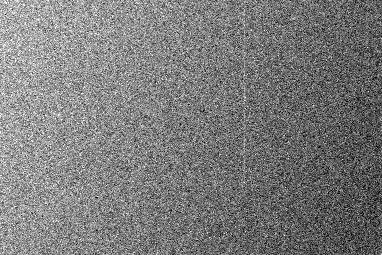 |
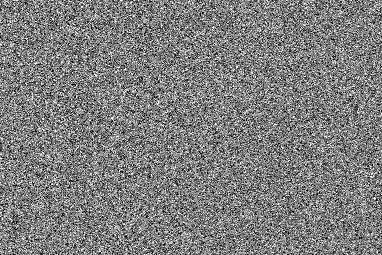 |
|
| CCD Support Frame 2x2 binning (#224803 + 224804) |
CCD Support Frame 2x2 binning (#224803 - 224804) |
The two flat frames were added together and the mean pixel value was measured μ(F1+F2). Next one flat frame was subtracted from the other and the standard deviation measured σ(F1-F2). The left-hand image below shows features in the total flat. The right-hand image below shows that subtracting one flat frame from the other removes any features in the flat leaving the total noise in the two flat frames. The noise is √2 times the noise in a single flat frame.
|
Sum of two flat frames |
Difference between same two flat frames |
|
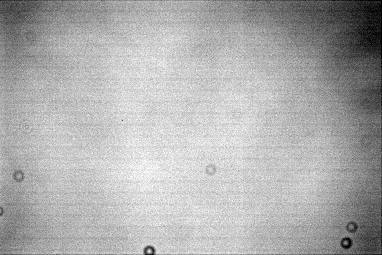 |
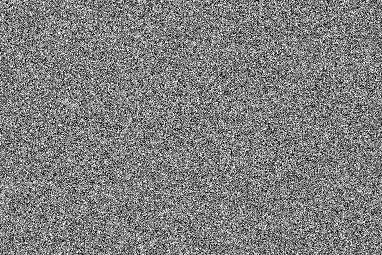 |
|
| CCD Support Frame 2x2 binning, 2s, C Filter (#224860 + 224861) |
CCD Support Frame 2x2 binning, 2s, C Filter (#224860 - 224861) |
The first bias frame was subtracted from the dark frame to provide the dark (thermal) current recorded over the integration period (D-B). The mean value was measured μ(D-B).
For a frame containing a high signal level such as a flat field frame, it can
be expected to display Poisson statistics when measured in electrons,
i.e.
σ
electrons = √μ
electrons
however since both σ
and μ have been multiplied by the
conversion factor or gain, g (in e-/ADU) we have actually measured
g.σ electrons =
√g.μ electrons
solving for g
g = μ
electrons / σ2 electrons
g = μ(F)
ADU / σ2 (F) ADU
A slightly more accurate figure for g can be obtained by subtracting the
influence of the bias mean and noise
g = μ(F1+F2) - μ(B1+B2)
(in e-/ADU)
-------------------------------
σ(F1-F2) - σ(B1-B2)
Calculations provided the following results
| Binning | Basic Test Estimate of Gain (e-/ADU) |
More detailed estimate of Gain (e-/ADU) |
||
| 1x1 | 2.93 | 2.88 | ||
| 2x2 | 2.59 | 2.63 | ||
| 3x3 | 2.59 |
These figures compare with an expected gain value of 2.3 e-/ADU.
It is non clear why higher gain figures are calculated but is seems to be real (whilst an ABG version might have a different gain to a non-ABG version, it would be expected if anything to have been given a lower gain rather than a higher gain in view of it's smaller well capacity).
The only source of noise in a bias frame should be the read-out noise. The sum of the readout noise in two bias frame has been measured from the standard deviation of the difference of two bias frames σ(B1-B2). And we know that this value is √2 times the noise in a single bias frame. Therefore we can calculate readout noise as follows :
σreadout = g.σ(B1-B2) / √2 [ in e-/pixel ]
Based on measurements and the gain values calculated above, the following readout noise results were obtained based on the average of 3 tests :
| Binning | Read-Out Noise (e-/pixel) | |||
| 1x1 | 13.60 | |||
| 2x2 | 14.20 | |||
| 3x3 | 15.25 |
These figures compare with an expected read-out
noise of 15 e-/pixel, and indicate that the camera is in good health.
A separate run in which Read-Out Noise was calculated for 2x2 binning at a 29
different set-point temperatures indicated a mean read-out noise of 14.1
+/- 0.2 e-/pixel
The mean dark current value of the 60s dark frame was converted to a dark current per second by dividing it by the integration time
D ADU = μ(D-B) / 60 [ in ADU/pixel/sec ]
or in electrons
D electrons = g.μ(D-B) / 60 [ in e-/pixel/sec ]
The following results were obtained based on 3 tests.
| Binning |
Dark Current at -25deg C (ADU/pixel/sec) |
Dark Current at -25deg C (e-/pixel/sec) |
|||
| 1x1 | 0.15 | 0.43 | |||
| 2x2 | 0.70 | 1.85 | 4.3 times 1x1 (~4) | ||
| 3x3 | 1.64 | 4.25 | 9.9 times 1x1 (~9) |
The figure of 0.43 compares with an expected dark current of 0.06 e-/pixel/sec (based on expected 1 e-/pixel/sec at 0 degC and a 6 degC doubling rate temperature). Notionally it would seem that the camera is underperforming in terms of dark current
A further sets of tests were carried out to understand the behaviour of the
camera under various states of cooling.
Using an automated routine developed for the task, sets of 3 bias and 3 x 60s
dark frames were acquired at 1 degC intervals of set point temperature between
-1 and -31 deg C , with 5 minute stabilisation periods after each temperature
set-point change.
For each step the average cooling power (%) and ambient temperature were
compiled from recorded data. The cooling power is placed in the FITS
header of each image, whilst ambient temperatures were taken from a log file of
telescope tube temperatures recorded by Optec TCF focuser. Ambient
temperature remained at around +1 degC through the test.
At the end of the cool-down period. the routine was used to record 1 bias and 1 x 60s dark frame at 3 degC intervals between -29 and -5 degC, with 10 minute stabilisation periods after each temperature set-point change.
For each temperature step the read-out noise was calculated from the standard deviation of the difference between pairs of bias frames (2x2 binning) and using a gain of 2.69 e-/ADU. Average readout noise for the 29 steps was 14.1 +/- 0.2 e-/pixel. A graph of read-out noise vs CCD temperature is shown below. As can be seen the data suggests that readout noise is pretty independent of temperature . However the mean bias itself is dependant on temperature and seems associated with dark current in the camera electronics as the bias frame is being read and counted.
|
Graphs of Mean Bias and Readout Noise vs CCD temperature (S324) |
||
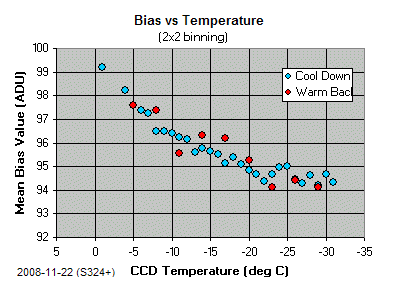 |
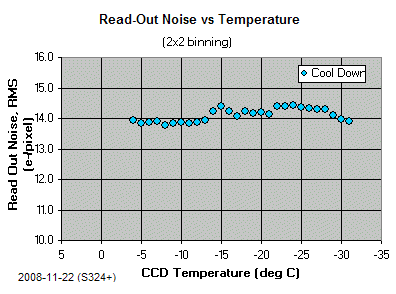 |
|
|
Graphs of Mean Dark Value and Dark Current vs CCD temperature (S324) |
||
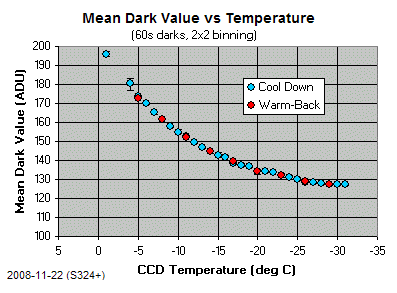 |
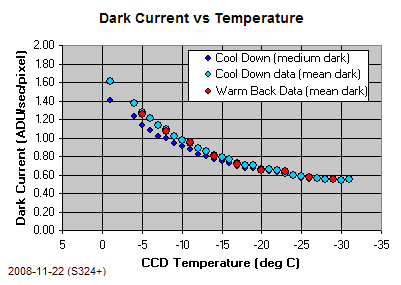 |
|
|
Graphs of Dark Current vs CCD temperature with simple model curves (S324) |
||
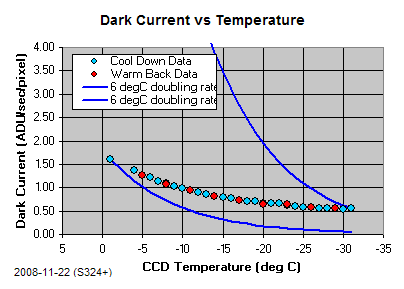 |
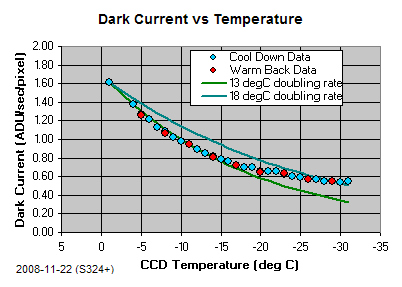 |
|
|
Graphs of Dark Current vs CCD temperature with best fitting models (S324) |
||
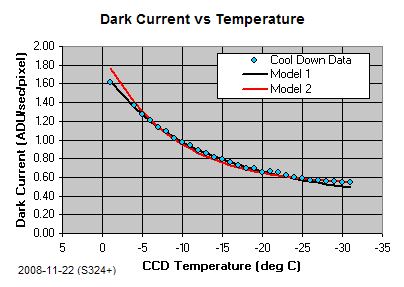 |
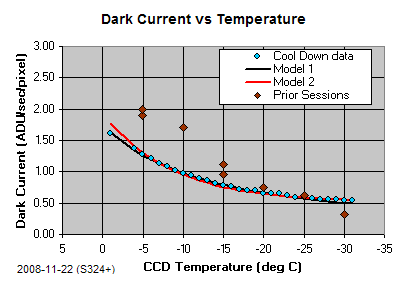 |
|
|
Gain Measurements / CCD
Transfer Curves (S324) |
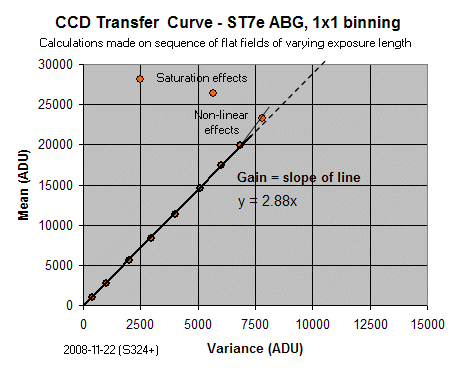 |
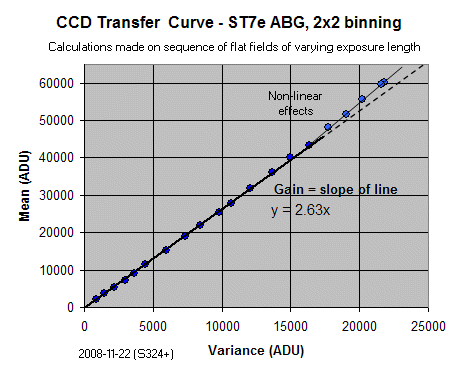 |
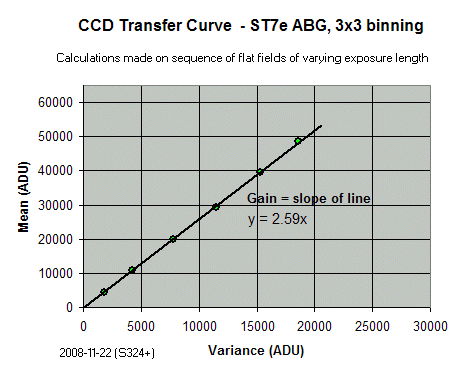 |
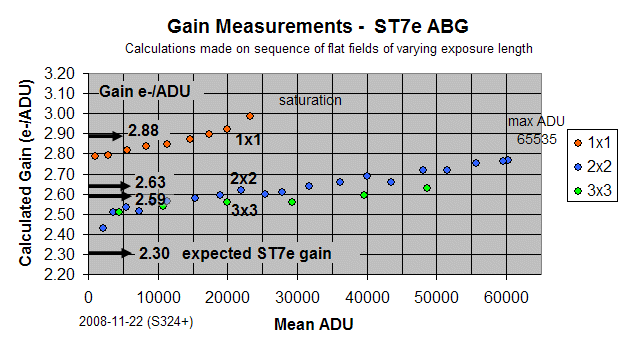 |
|
Linearity Tests (S324) |
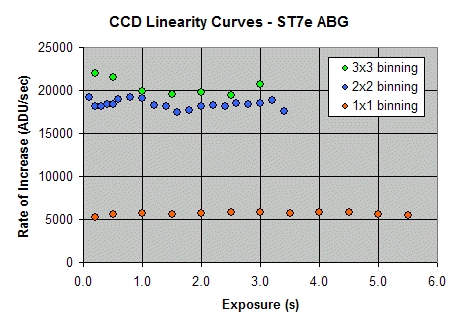 |
Back to Top
| This Web Page: | Notes - Session 324 (2008-11-16) |
| Last Updated : | 2015-05-16 |
| Site Owner : | David Richards |
| Home Page : | David's Astronomy Web Site |